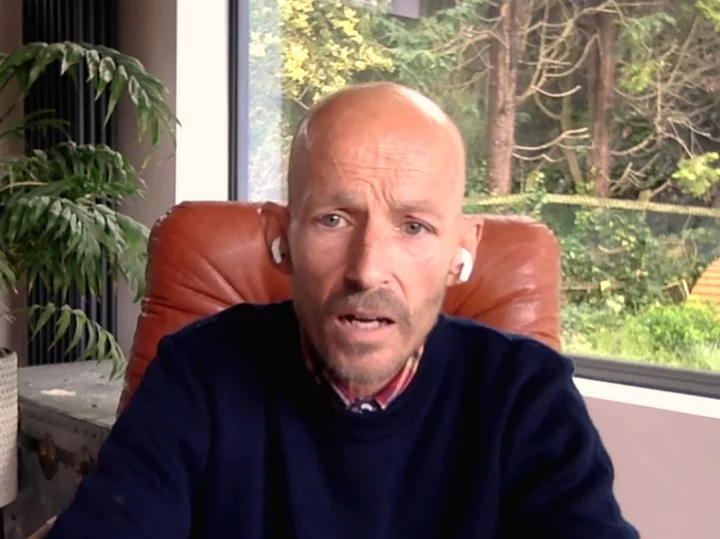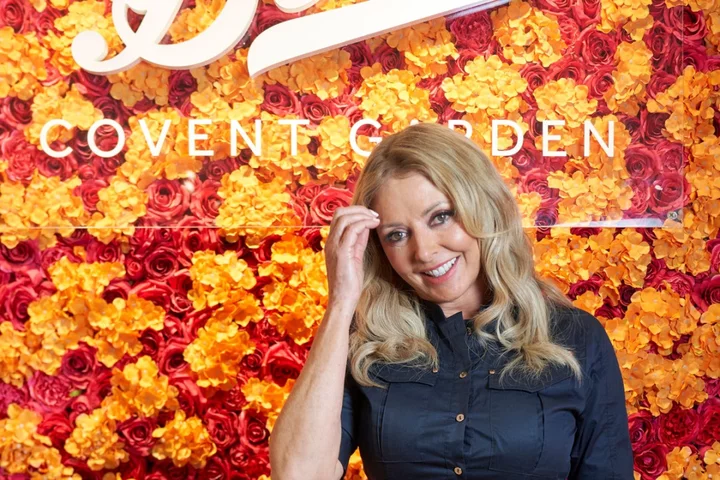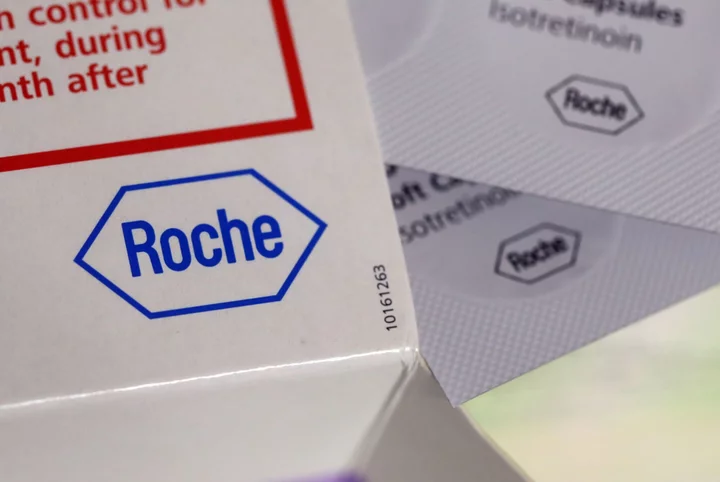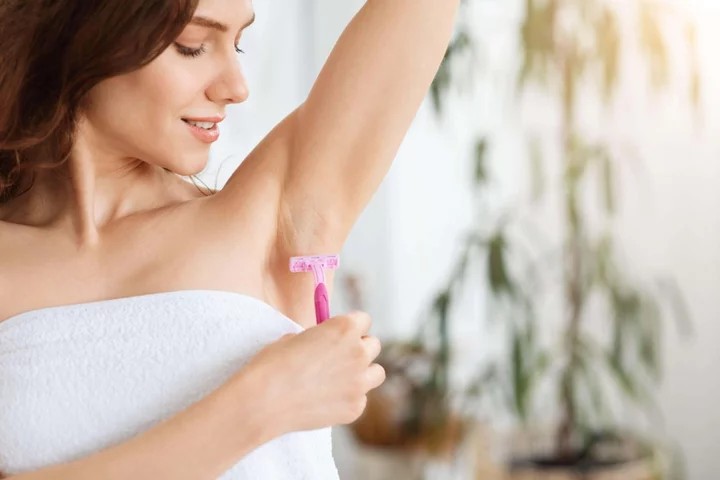
South Africa media guide
Overview of the media in South Africa, including links to broadcasters and newspapers.
2023-07-24 18:20

Owen Wilson regrets not getting to work with Jamie Lee Curtis on Haunted Mansion
Owen Wilson was disappointed not to share any scenes with Jamie Lee Curtis in the new Disney movie 'Haunted Mansion'.
2023-07-24 17:55

‘It’s not the doom and gloom you might think’: Jonnie Irwin details experience with palliative hospice care
Jonnie Irwin has spoken out about his “really good” experience with palliative care in a hospice, amid his journey with terminal cancer. The A Place In The Sun presenter, 49, appeared on BBC Morning Live on Monday (24 July) and gave viewers an update on his current health and treatment. Reassuring hosts Gethin Jones and Helen Skelton that his family is doing “great and very noisy”, Irwin was asked about his experience with palliative care, which focuses on improving the quality of life for anyone facing a life-threatening condition. Irwin said that he has been in palliative care since the day he received his terminal cancer diagnosis. He was first diagnosed with lung cancer in August 2020, but only publicly shared the news in November 2022 after it spread to his brain. He described his hospice experience as a “delight”, adding that his initial perception of such facilities were that they were “very much a boiling hot room full of people who looked frail and towards the end of their days”. However, it was “nothing of the sort” when he did actually go in. “It’s spacious, energised, comfortable,” Irwin told the show, adding: “I’ve had a really, really good experience at my hospice.” He urged anyone who is facing a terminal diagnosis to “embrace” end-of-life care and to try going to a hospice if they have been offered the choice. “My first experience of palliative care and hospice was blood transfusions,” he explained. “I had my first blood transfusion in hospital and then was invited to use the hospice, so I have it a go as a day patient and went into a lovely room. “I implore people to check out hospices. If you’ve got the choice of using it, then use it… I encourage people to explore that option because it’s not the doom and gloom operation you might think it was.” In June, Irwin made a rare red carpet appearance at the Television and Radio Industries Club (TRIC) Awards and said he is taking “every day as a gift as it comes”. When he first revealed his terminal cancer diagnosis, the Escape To The Country host said he “doesn’t know how long” he has left to live, but hopes he will inspire people to “make the most of every day”. He also celebrated his “best ever” Father’s Day last month with his three sons, Rex, four, and twins Rafa and Cormac, three, with wife Jessica Holmes. Irwin recently revealed that sometimes he has to “remove himself” from his family home to go to a hospice when he is in a lot of pain because it makes him “not good to be around”. He told Hello! magazine: “I’m like a bear with a sore head and I don’t want [my family] to be around that.” In another appearance with podcast OneChat previously, he said that being in pain affects his mood, explaining: “I have been close to death’s door, twice at least. You lose your memory, you lose your patience. I have got a very short temper. It’s not made me a better person, that’s for sure.” Read More Ruth Handler: The Barbie inventor who revolutionalised prosthetic breasts and narrowly avoided prison Fans defend Prince Harry and Meghan Markle amid breakup rumours Tim Shaddock rescue: Ben Fogle offers to pay for Australian sailor and dog to be reunited after emotional separation Carol Vorderman shares warning to sunbathers after skin cancer scare This is how often you should actually change your razor Are we working out too hard?
2023-07-24 17:22

Carol Vorderman shares warning to sunbathers after skin cancer scare
Carol Vorderman was well and truly a sun worshipper growing up. “Oh God, yes. I was burning away merrily for many, many years,” she remembers with a groan. The former Countdown presenter, 62, says her generation was the first to really become obsessed with the sun. “I’m of the generation where we started to sunbathe – my mother’s generation didn’t. We were also caught in the formative years, the 60s, 70s, 80s, where we had absolutely no idea of what sun protection was – you just couldn’t buy it. I think it was the 90s that began,” she explains. “So in all of our youth we were encouraging each other to sunbathe doused in cooking oil.” Vorderman remembers the ways people would try and boost their tan – from sunbathing surrounded by metal foil (so you could “get all the rays of the sun” and “burn nicely”) to discovering sunbeds (“we thought they were marvellous”) – and she was particularly keen on soaking up as much of the sun as possible, as she grew up by the sea. She says anyone her age “will remember all that”, but now “we know the dangers”. Vorderman is unsurprised by Cancer Research UK’s latest statistics, showing melanoma skin cancer cases in the UK have reached an all-time high. According to the charity, 17,500 cases are diagnosed every year, with projections suggesting the numbers could increase by 50% over the next 20 years. Research suggests people around Vorderman’s age are increasingly affected, with the probability of people aged 55 and older getting skin cancer almost tripling since the 1990s. Bristol-based Vorderman herself had a scare when she was around 50. She was concerned by some changes in her skin, so went to see a dermatologist – who sent off a biopsy for testing, with results revealing the cells were precancerous. The presenter is at pains to emphasise she doesn’t want people to feel sorry for her – “I had no symptoms, nothing like that” and the cells were removed – but she’s instead trying to highlight how crucial it is to be sun safe. “What I do now is I’ve had a check-up every year, all over, ever since,” she says – and that isn’t the only change she’s made. “I slather myself in SPF at all opportunities. In many ways, the damage is already done, but I don’t sunbathe now, or I cover myself up.” Vorderman has teamed up with Boots brand Soltan and Macmillan Cancer Support on a sun-safety campaign, and her efforts to raise awareness around the issue aren’t just inspired by her own experiences. Her mother died in 2017 after suffering from three types of cancer – the third being melanoma. “Not a single time in her life did she sunbathe – my mum had a different skin to me, she had moles, I don’t,” Vorderman says. “I know that makes you much more prone to melanomas.” Cancer Research UK cites a study that found melanoma risk was higher in people with more than 100 moles compared with people who have fewer than 15 moles. For Vorderman, talking about these issues, whether publicly or among friends, is key. “It’s part of life. The more we talk about it, the better it is – as with everything. It’s like talking about the menopause, talking about women’s issues, talking about all sorts of cancers… As we know with all cancers, the sooner you can have something checked, the better the outcome should be.” Vorderman has in recent years made a name for herself for posting her unfiltered political beliefs on social media, and whether it’s talking about politics or causes close to her heart, she won’t back down. “I’ve always been pretty confident, but now you get to a point in life where you think – I feel strongly about things as they stand in this country at the moment. I’ve never known anything as bad. I think everyone should speak out.” She believes in the old saying: ‘The only thing necessary for evil to triumph is for good people to say nothing’, adding: “I take that with me.” Read More Charity boss speaks out over ‘traumatic’ encounter with royal aide Ukraine war’s heaviest fight rages in east - follow live Carol Vorderman: Why my skin cancer scare means I no longer sunbathe This is how often you should actually change your razor Are we working out too hard?
2023-07-24 17:18

Roche Signs $2.8 Billion Alnylam Deal for Hypertension Drug
Roche Holding AG will work together with Alnylam Pharmaceuticals Inc. on a potential treatment for high blood pressure
2023-07-24 16:49

Carol Vorderman: Why my skin cancer scare means I no longer sunbathe
Carol Vorderman was well and truly a sun worshipper growing up. “Oh God, yes. I was burning away merrily for many, many years,” she remembers with a groan. The former Countdown presenter, 62, says her generation was the first to really become obsessed with the sun. “I’m of the generation where we started to sunbathe – my mother’s generation didn’t. We were also caught in the formative years, the 60s, 70s, 80s, where we had absolutely no idea of what sun protection was – you just couldn’t buy it. I think it was the 90s that began,” she explains. “So in all of our youth we were encouraging each other to sunbathe doused in cooking oil.” Vorderman remembers the ways people would try and boost their tan – from sunbathing surrounded by metal foil (so you could “get all the rays of the sun” and “burn nicely”) to discovering sunbeds (“we thought they were marvellous”) – and she was particularly keen on soaking up as much of the sun as possible, as she grew up by the sea. She says anyone her age “will remember all that”, but now “we know the dangers”. Vorderman is unsurprised by Cancer Research UK’s latest statistics, showing melanoma skin cancer cases in the UK have reached an all-time high. According to the charity, 17,500 cases are diagnosed every year, with projections suggesting the numbers could increase by 50% over the next 20 years. Research suggests people around Vorderman’s age are increasingly affected, with the probability of people aged 55 and older getting skin cancer almost tripling since the 1990s. Bristol-based Vorderman herself had a scare when she was around 50. She was concerned by some changes in her skin, so went to see a dermatologist – who sent off a biopsy for testing, with results revealing the cells were precancerous. The presenter is at pains to emphasise she doesn’t want people to feel sorry for her – “I had no symptoms, nothing like that” and the cells were removed – but she’s instead trying to highlight how crucial it is to be sun safe. “What I do now is I’ve had a check-up every year, all over, ever since,” she says – and that isn’t the only change she’s made. “I slather myself in SPF at all opportunities. In many ways, the damage is already done, but I don’t sunbathe now, or I cover myself up.” Vorderman has teamed up with Boots brand Soltan and Macmillan Cancer Support on a sun-safety campaign, and her efforts to raise awareness around the issue aren’t just inspired by her own experiences. Her mother died in 2017 after suffering from three types of cancer – the third being melanoma. “Not a single time in her life did she sunbathe – my mum had a different skin to me, she had moles, I don’t,” Vorderman says. “I know that makes you much more prone to melanomas.” Cancer Research UK cites a study that found melanoma risk was higher in people with more than 100 moles compared with people who have fewer than 15 moles. For Vorderman, talking about these issues, whether publicly or among friends, is key. “It’s part of life. The more we talk about it, the better it is – as with everything. It’s like talking about the menopause, talking about women’s issues, talking about all sorts of cancers… As we know with all cancers, the sooner you can have something checked, the better the outcome should be.” Vorderman has in recent years made a name for herself for posting her unfiltered political beliefs on social media, and whether it’s talking about politics or causes close to her heart, she won’t back down. “I’ve always been pretty confident, but now you get to a point in life where you think – I feel strongly about things as they stand in this country at the moment. I’ve never known anything as bad. I think everyone should speak out.” She believes in the old saying: ‘The only thing necessary for evil to triumph is for good people to say nothing’, adding: “I take that with me.” Broadcaster and author Carol Vorderman MBE is working with Boots brand Soltan, which is joining forces with Macmillan Cancer Support for the second year running, as its official sun-safety partner.
2023-07-24 16:46

This is how often you should actually change your razor
Reckon you could get another shave out of your razor? We’ve all done it, wondering how long we can actually use one, as we whip it out again and again. Well, it may not be worth the risk to your health, according to dermatologist and Dove expert, Dr Cristina Soma. So, how often should you change your razor? “More people cling on to their razors for much longer than is advised, and are surprised when we recommend that a razor is changed every five to seven shaves,” says Soma. “The frequency of change also depends on other factors, such as how frequently and how many areas you shave, your hair thickness and type, the quality of your blade, and whether you are good at washing it off afterwards and looking after your blade.” What happens if you don’t? “Most of us own a dull blade full of skin cells, soap and hair debris. In the worst cases, you can also see rust on the blade,” Soma says. “When all this grime accumulates and the blade dulls, you are less likely to get a close, smooth shave, and more likely to cut yourself. Bacteria can accumulate on the blade and have some serious consequences, too. “Using a dull razor blade can result in shaving rash and bumps, ingrown hairs, and inflamed or traumatised skin. More seriously, it can result in cuts and possibly lead to infections,” she explains. Infections “You could get any kind of infection from using an old, unsharp razor. After a while of using the same blade, bacteria starts to grow, which will create irritation on your underarms,” she explains. Shaving armpits, pubic hair and legs may cause real issues. “The most common form of infection would be a bacterial skin infection, with symptoms including redness, swelling, pain or pus. Treatment for this would be an antibiotic ointment. “To really care for your underarms, you need to change your razor frequently, use a shaving cream or gel, shave in the direction of hair growth and rinse the blade thoroughly, then store it in a clean, dry place. “Furthermore, the underarm area is very delicate, so take care in choosing a deodorant that supports the skin barrier,” explains Soma. Resistance and irritation If you feel any resistance when shaving with an old razor, it could cause an issue. “If you can feel your razor tugging at your hair, rather than gliding over it smoothly, it’s likely blunt and will cause skin irritation, razor burn and ingrown hairs,” says Dr Tim Clayton, consultant dermatologist at Pall Mall Medical in Manchester. “Ingrown hairs can lead to bacterial infections, hyperpigmentation and keloids [a type of raised scar] so it’s important to avoid these where possible,” he says. Rust If you see a hint of orange on there, it isn’t worth using. “Tetanus can be spread via a wound caused by a rusty object, but it isn’t the rust that will cause tetanus – it’s the bacteria on the razor. “If you’re concerned about contracting tetanus, make sure you’re up to date with your tetanus vaccinations,” says Clayton. Concerns about cost In a 2021 International Journal of Women’s Dermatology study, women’s four-blade razors were priced 66% higher than men’s, who may be less inclined to shave their bodies. So, if changing your razor is costly, it may be worth considering your relationship with your body hair. “There is no hygiene benefit to shaving your body hair. What you choose to do is completely up to you,” says Soma. “Increasingly, we are seeing more acceptance and diversity in what people do with their hair, and from a medical standpoint, as long as you’re doing it in a hygienic and safe way, carry on.” Read More Charity boss speaks out over ‘traumatic’ encounter with royal aide Ukraine war’s heaviest fight rages in east - follow live Are we working out too hard? How to perk up urban balcony gardens and window boxes Sadiq Khan and Romesh Ranganathan: Women still aren’t equal in politics and comedy
2023-07-24 16:21

Are we working out too hard?
There’s a reason high-intensity interval training (HIIT) is so popular – it’s designed to give you a killer workout in a short amount of time. HIIT classes are short, sharp bursts of exercises where you’re working out above 85% of your maximum heart rate, and Sean Johnson, regional fitness manager at Orangetheory Fitness, can see why they’re “tempting”. “A lot of people are pressed for time and seek a ‘quick fix’. To many people, the assumption is ‘no pain, no gain’ and so therefore seek out a hard-hitting, pulse-shattering workout to undo the unhealthy habits they may have gotten themselves into,” he says. “A hard workout can feel very rewarding when you move fast and blast around for a short time.” Plus, there are benefits to HIIT training, with Johnson saying: “A shorter, more intense workout does have the ability to elicit a longer afterburn compared to a less intense longer workout.” But is there a chance we’re overdoing it, in a bid to ‘get the most’ out of our workouts? There’s a growing trend for lower intensity exercise – often using a heart rate monitor so you can track where you’re at – which might provide a whole host of benefits, without making you feel a bit sick. Signs you might be overdoing it “Working at a maximal heart rate can sometimes cause people to feel lightheaded, dizzy, faint and nauseous. This isn’t very fun and can also deter people from coming back,” suggests Francesca Sills, exercise physiologist at Pure Sports Medicine. Johnson agrees: “Working out for too long at an intensity that is too high can put numerous stresses on the body such as fainting, vomiting and even serious cardiovascular and respiratory health issues.” A heart rate monitor can help you track how hard you’re pushing yourself, but if you don’t have one, Johnson recommends going by “feeling”. Orangetheory uses three terms to define your perceived exertion: “Base pace is a ‘challenging, but doable’ feeling, push pace is an ‘uncomfortable feeling’ and all out is an ‘empty the tank feeling’,” Johnson explains. He doesn’t recommend spending more than a minute in the ‘all out’ section, and other signs you might be overdoing it include “fatiguing earlier than you normally do, dizziness, light headed, you get injured or have joint and muscle pain regularly”. Downsides to HIIT? Sills suggests there aren’t necessarily downsides to HIIT, just “things to be wary of”. She says: “If you’re working very hard for a long time or for longer than you are used to, it’s possible that you’ll finish the session feeling unwell rather than energised.” Johnson says there is the risk of overtraining with regular HIIT classes. “In the shorter term, working out at an intensity too high can stress your adrenal glands and stimulate the release of cortisol (the stress hormone). In turn, this can have numerous side effects such as increased blood pressure, increased heart rate, encourage fatigue and ultimately hinder recovery. “If your body cannot recover properly, you will find it hard to get into a regular routine with your fitness and will see a lack of results.” The benefits of slowing down Johnson suggests incorporating lower-intensity exercise into your routine can improve your everyday life. “Doing workouts that don’t raise your heart rate to the extremes can help reduce the risk of injury (and risk of falls and trips), reduce fatigue and pain, elevate your mood, improve sleep quality, while still helping to burn calories,” he says. Sills mentions how ‘zone two’ workouts are a “hot topic” in the fitness world recently – this is a type of low-intensity, sustained exercise where you’re working at around 65-75% of your maximum – for example, going for a gentle jog where you can still hold a conversation. She says these types of workouts are gaining popularity because of the “large amount of benefit it brings to the health and efficiency of your cardiovascular and metabolic systems”. If you’re used to leaving it all on the floor with an intense workout every time you hit the gym, it can be tricky to know how to slow down. Johnson recommends using the ‘FITT principle’ to adjust your exercise routine: Frequency: Instead of doing your four workouts next week try doing only threeIntensity: Do your normal four workouts, but take it down a notch in each one.Time: Instead of doing four x 90 minute workouts next week, maybe try doing four x one hour workouts.Type: Switch it up and use different equipment or style of workout. Johnson adds: “Having slower days will enable you to focus more on the form and technique, which transfers over to the high intensity days as well.” Doing HIIT safely While it’s a good idea to mix up your workouts with different intensities, there are a few things you can do to make sure you don’t overdo it in HIIT. Sills recommends ensuring “you are eating well to fuel your body for performance”, and “get on top of your sleep routine to allow your body to rest and repair”. If you’re a newbie to exercise, she wouldn’t necessarily recommend a HIIT class immediately: “If you haven’t done much training before, it’s important to learn how to do things right and build a good base level of strength and fitness before going in and smashing yourself. If you aren’t sure how to perform exercises well when you’re fresh, you aren’t setting yourself up for success when you’re fatigued.” And finally, she says: “It’s important to work within your own limits. Often these classes are busy, loud and intense and people can be encouraged to continue to do more weight, more reps, etc. Issues arise when people push too far beyond what they can manage. Instead of working at a 10/10 all the time, drop it back to an eight to nine.” Read More Charity boss speaks out over ‘traumatic’ encounter with royal aide Ukraine war’s heaviest fight rages in east - follow live How to perk up urban balcony gardens and window boxes Sadiq Khan and Romesh Ranganathan: Women still aren’t equal in politics and comedy SPF cocktailing: Why you should steer clear of the buzzy TikTok trend
2023-07-24 15:47

'I have never witnessed a greater sacrifice by a lead actor': Robert Downey Jr praises Cillian Murphy
Robert Downey Jr has praised Cillian Murphy's "sacrifice" to play theoretical physicist J. Robert Oppenheimer in Christopher Nolan's 'Oppenheimer'.
2023-07-24 15:23

Paramore postpone shows due to sickness
Paramore have cancelled their fourth concert due to illness within the touring party.
2023-07-24 15:19

What to stream this week: Post Malone, Zach Galifianakis, 'This Fool,' Thandiwe Newton and 'Heels'
This week’s new entertainment releases include a new album from Post Malone, a movie starring Zach Galifianakis about the creation of the cute collectable Beanie Babies and a video game for the whole family with Disney Illusion Island
2023-07-24 12:20

Taylor Swift's surprise song at Seattle concert hypes next potential 'Taylor's Version' album
The inimitable Taylor Swift has been on her record-breaking "Eras" tour and along the way, she's played a different "surprise song" to change up the setlist at every concert.
2023-07-24 09:24
